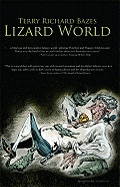
| Publisher: | Livingston Press/University of West Alabama | |
| Genre: | General, Gothic, Fiction, Horror | |
| ISBN: | 9781604890778 | |
| Pub Date: | October 2011 | |
| Price: | $22 |
| Fiction |
by Terry Richard Bazes
Lizard World is a Frankenstein brew of two alternating tales--the first written in an 18th-century style reflecting its period setting and the second offering a zany, macabre vision of Florida. Terry Richard Bazes's historical pastiche, channeling Smollet and Cleland, tells the tale of the Earl of Griswold, a self-made libertine who discovers a perfume that can be extracted from alligators. The quirky modern story introduces the Earl's distant, wacked-out relatives, led by Lizard World proprietor Lemuel Lee Frobey, and a poor dentist, Max Smedlow, who is imprisoned by Frobey's clan--including Earl, "a veterinary surgeon of genius"--after running over one of their gators.
Once you accept the notion (established in the 18th-century storyline) that a body part can be removed from one person--or animal--and successfully attached to another body, it won't take long before you begin to smell the fate of poor Max, his brain in particular, and its ultimate 300-year-old home. Bazes's subversively hilarious narrative of nonstop Marx Brothers zaniness sets one's mind a-spinning, but Lizard World itself is hard to classify. We could call it, perhaps, a "Shandyesque" concoction, with a dab of mash-up lit, and seasoned with gothic whimsy. In other words, one of those books in which many other works live, though some readers may find it a bizarro world that goes a little too over the top, a little too often. --Tom Lavoie, former publisher
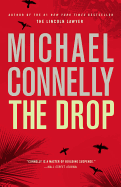
| Publisher: | Little, Brown | |
| Genre: | Crime, Police Procedural, Fiction, Mystery & Detective, Thrillers | |
| ISBN: | 9780316069410 | |
| Pub Date: | November 2011 | |
| Price: | $27.99 |
| Mystery & Thriller |
by Michael Connelly
In The Drop, Michael Connelly's long-running protagonist, Det. Harry Bosch, faces end-of-career issues in the Los Angeles police department's Open/Unsolved Unit. In one day, he gets two hits: a DNA match on a 21-year-old murder-rape case and an unexpected fresh body. The son of Councilman Irvin Irving--Bosch's nemesis from previous novels in the 17-book series--has jumped or been dropped from his hotel balcony, and Irving inexplicably requests Bosch as investigator. It looks to be a case of "high jingo"--political complications threatening the quest for truth and justice to which Bosch is so committed.
As the Irving case gains momentum, the politics threaten to engulf an old friend and colleague, and Bosch may have no one left that he can trust. Meanwhile, logic contradicts fact as the blood found on the victim of the unsolved murder-rape belongs to a man who was eight years old at the time of the crime. Even Bosch's new partner seems to be working against him. Worst of all, he begins to doubt his own abilities: is Bosch too old for the job?
Fans of Connelly's series will exult in another round of Bosch-versus-the-world (and the LAPD); he exhibits all his old charms and skills, as well as tenderness towards his teenage daughter (who develops in her own right as a character). New readers will follow the action perfectly; The Drop can confidently stand alone. The evocation of the Los Angeles setting is lovely as usual, and the action's crescendo hits all the right notes. Don't take your eyes off Connelly yet--Bosch is ready to fight another round. --Julia Jenkins, librarian and blogger at pages of julia

| Publisher: | Minotaur | |
| Genre: | Fiction, Mystery & Detective, Traditional British, Historical | |
| ISBN: | 9780312591458 | |
| Pub Date: | November 2011 | |
| Price: | $25.99 |
| Mystery & Thriller |
by Marjorie Eccles
Before leaving the police force to serve in the First World War, Sergeant Herbert Reardon investigated the drowning death of a girl in a remote West Country village. Home from the war and still haunted by the case's unsatisfactory conclusion, he returns to the village to explore it further. When a maid is found murdered, Reardon believes the deaths--though they took place five years apart--must be linked, and he begins asking questions. Did Marianne Wentworth jump to her death or did someone push her? Who was she meeting the night she died? And which family members know more than they are telling?
Eccles (Last Nocturne; The Shape of Sand) paints a finely detailed portrait of life in a small English village, showing the far-reaching effects of the Great War. The mystery unfolds slowly alongside such signs of cultural upheaval as the shifting of social class boundaries and the possibility of new careers for young women. As Reardon probes deeper into Marianne's drowning, he must also decide how to forge a new life for himself. The village inhabitants--most notably Marianne's sister, Nella, who served as a nurse in France--are grappling with the same issues.
Fans of Jacqueline Winspear's Maisie Dobbs series, and those interested in the history of the Great War and its aftermath, will appreciate Eccles's skillful portrayal of life in the trenches and on the home front, as well as the novel's complex saga of family secrets, love and loss. --Katie Noah Gibson, blogger at Cakes, Tea and Dreams

| Publisher: | Minotaur | |
| Genre: | Fiction, Police Procedural, Mystery & Detective | |
| ISBN: | 9780312642839 | |
| Pub Date: | November 2011 | |
| Price: | $25.99 |
| Mystery & Thriller |
by Peter James
A nasty traffic accident in an English coastal town involves a bicyclist, a car, a van and a delivery truck. The bicyclist dies, which is awful enough, but it turns out he's an American college student whose parents have Mafia connections. Sussex police soon find the bodies of the van and truck drivers, along with evidence that their torture deaths had been videotaped. Detective Superintendent Roy Grace and his team realize they're in a race against time to save Carly Chase, the driver of the car, from a similarly gruesome fate.
Dead Man's Grip is the seventh novel in the Grace series, but it contains enough backstory to bring first-time readers up to speed. Besides the challenging case, Grace is preparing for impending fatherhood with his fiancée, Chloe, who experiences pregnancy complications. But first, he must have his beloved wife, Sandy, who went missing 10 years earlier, declared legally dead--which might be harder than he imagined.
James delivers an accessible police procedural, not weighed down by technical jargon, and keeps the pace thrumming along. Although Carly does something so incredibly ill-advised in the last third of the book that some readers may stop caring what happens to her, Grace is a decent man with his heart in the right place, appealing enough that readers will root for him to close the case successfully. --Elyse Dinh-McCrilllis, freelance writer/editor, blogging at Pop Culture Nerd
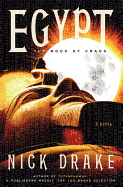
| Publisher: | Harper | |
| Genre: | Fiction, Mystery & Detective, Historical | |
| ISBN: | 9780060765941 | |
| Pub Date: | December 2011 | |
| Price: | $25.99 |
| Mystery & Thriller |
by Nick Drake
Egypt has fallen on dark, frightening times. The pharaoh Ay is near death and Ankhsenamun, daughter of Nefertiti, has not provided him with an heir. Rottenness at all governmental levels, coupled with the threat of the ruthless and ambitious General Horemheb, and the growing turbulence among kingdoms to the East has prompted one poet to write, "Violence walks the ways,/ Evil runs rampant."
Egypt: The Book of Chaos is the concluding novel of Nick Drake's ancient Egyptian trilogy, after Nefertiti (shortlisted for the Ellis Peters Historical Crime award) and Tutankhamun. Rahotep, Seeker of Mysteries, has fallen from his position of power in the Thebes Medjay (police), consigned by his viciously petty boss to only the most superficial aspects of investigations--including the appallingly cruel murder of five young low-level opium runners. Finding a papyrus scrap inscribed with a strange symbol in one victim's mouth, Rahotep pockets this, sharing it only with his partner, Khety; Khety's sadistic murder, some days later, propels Rahotep into a personal investigation of the crime.
Rahotep's search for answers dives deep into the dark, gritty heart of a corrupt and dangerous society, as he accompanies his oldest friend Nakht, of the inner circle of royal advisers, on a political mission whose urgency is matched only by its secrecy. Ignoring repeated warnings to leave the murders alone, Rahotep continues his investigation as he journeys north along the opium supply route (which still exists today). Along the way, he faces kidnapping, torture, addiction and death--either from the sinister Obsidian, head of the new opium trade, from Egypt's Hittite enemies, or from the hands of Horemheb himself. This tightly crafted, brooding plunge into the frightening fin de siècle of the XVIII dynasty will leave readers satisfied as well as regretful that The Book of Chaos is the last in Drake's series. --Judith Hawkins-Tillirson, proprietress, Wyrdhoard Books, and blogger at Still Working for Books
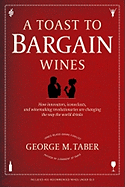
| Publisher: | Scribner | |
| Genre: | Beverages, Cooking, Wine & Spirits, Reference | |
| ISBN: | 9781439195185 | |
| Pub Date: | November 2011 | |
| Price: | $15 |
| Food & Wine |
by George M. Taber
Thomas Jefferson once called wine a necessity of life--and so it is, compared to such amenities as satellite TV and organic cacao beans. However, when one is standing in the grocery aisle debating between the pasta and the sauce, unable to afford both, the wine racks seems laughably far from vital. If, on the other hand, one is married to a self-declared wine snob, it might also seem laughable to return without a corked bottle (and most likely a particular one at that). Never mind sauceless pasta; the very idea of attending this week's dinner party without a respectable offering of Pinot! The humiliation of admitting one might--occasionally--pour one's libation from a box!
Enter George M. Taber and A Toast to Bargain Wines. The first task of Toast is to remove the stigma of bargain wine. Taber's experience lends itself well to this endeavor: in 1976, for instance, Taber witnessed an infamous blind wine tasting at which supposed French experts were unable to distinguish between varietals or even deduce which wines were produced in France and which elsewhere. In this fashion, he goes on to debunk the industry's near-fetishistic obsession with name brands, esoteric concepts and expense.
Once we have been empowered with the knowledge that even prized palates can be wrong, Taber definitively answers the question, "What's a flat-broke oenophile to do?" with a comprehensive list of widely available and very drinkable wines for under $10. Quality bargain brands such as Yellow Tail, so often cast as villains, are finally offered roles as Robin Hoods in Toast. The arrival of this title is impeccably timed for those of us with limited means, but even those fortunate few still in the black will find Taber's perspective as refreshing as... well, a good glass of wine. --Katherine Montgomery, book (and wine) nerd
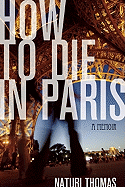
| Publisher: | Seal Press | |
| Genre: | Biography & Autobiography, Women, Family & Relationships, Child Abuse, Abuse, Personal Memoirs | |
| ISBN: | 9781580053648 | |
| Pub Date: | November 2011 | |
| Price: | $17 |
| Starred | Biography & Memoir |
by Naturi Thomas
Naturi Thomas's How to Die in Paris is astonishing. It may look like yet another in the endless parade of "young woman goes to foreign country and finds herself" books trailing in the wake of Eat, Pray, Love, but this is an altogether different type of story--an unflinching tale of self-discovery at life's lowest possible point.
Simply put, Thomas goes to Paris to kill herself. She steps off the train with six euros in her pocket and suicide plans in place: buy poison, take it and die. Instead, she spends three weeks unable to take her life but lost as to how to live it. With no food, no friends and less than a euro left, her miserable Parisian reality is interwoven with memories of her mother, whose mood swings, multiple personalities and grand delusions made Thomas's girlhood magical and terrifying by turns. Thomas's father stood helpless in the face of his wife's tempests; her brother alternated between blank silence and unwavering optimism. A string of failed jobs, a burned-out relationship with a married man, and a mother she cannot talk to without losing her own mind push Thomas to near-fatal despair. Instead, she faces the worst of her demons, learning at long last to forgive--and to love--the abused inner child who has prevented her from reaching so much. In a memoir at once spellbinding and wonderfully honest, Thomas reveals how she died in Paris--and lived. --Dani Alexis Ryskamp, blogger at The Literary Cricket
The City of Light illuminates the dark corners of the soul in an astonishingly clear and honest memoir.
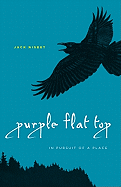
| Publisher: | University of Washington Press | |
| Genre: | United States, Travel, Pacific - Washington, Essays & Travelogues, Essays, Regional, Nature | |
| ISBN: | 9780295991214 | |
| Pub Date: | August 2011 | |
| Price: | $18.95 |
| Nature & Environment |
by Jack Nisbet
Twenty-five years ago, Jack Nesbit published Purple Flat Top: In Pursuit of a Place, a collection of weekly newspaper columns he'd written after he and a friend arrived in a remote area of northeastern Washington and began to build a home out of the natural stone they found there. Since then, Nesbit has become an award-winning author, a well-recognized naturalist and one of the great storytellers of the American Northwest. But Purple Flat Top fell out of print and became difficult to find--until this reissued edition from the University of Washington Press. (Apart from a new cover and a new preface, the contents are unchanged from the original printing.)
Nesbit writes with a simple and clear voice, but also with a powerful gift for observation and reflection. He is perhaps most eloquent when describing the landscape in which he works and plays. As he arrives in the Purple Flat Top region for the first time, Nesbit notes, "To our right a jumble of rocks marched uphill toward the blunt shoulder of the escarpment; to our left a brushy slope bursting with serviceberry and hawthorn blooms fell away to a noisy creek far below. A line of high mare's-tail clouds raced across the sky, and everything about the place seemed sharp and new." His skillfully shaped vignettes of the area's human and animal residents are filled with subtle humor. Purple Flat Top is worth revisiting if it has been read before or experiencing fully anew if it has not. --Roni K. Devlin, owner of Literary Life Bookstore & More
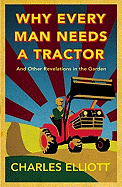
| Publisher: | Frances Lincoln | |
| Genre: | Gardening, Essays | |
| ISBN: | 9780711232396 | |
| Pub Date: | October 2011 | |
| Price: | $19.95 |
| Gardening |
by Charles Elliott
After Charles Elliott was done with his publishing job at Knopf, he and his wife moved to Wales. Since then, he has been gardening to his heart's delight--even though he's no longer able to grow sweetcorn--and turning out books (such as The Transplanted Gardener) that collect his published essays and book reviews. The 31 pieces in Why Every Man Needs a Tractor reveal a witty, leisurely style, friendly and welcoming, like a gentleman guide enthusiastically showing you around his garden.
His pieces are a delight to read. They are filled with the same kind of joyful enthusiasm Elliott himself experienced when he got to visit Prince Charles's secluded gardens. Each piece is like a short story, a fireside chat. We're told fascinating facts: it took some 36,000 people to care for the gardens at Versailles, for example, and it pretty much destroyed the French economy. We're introduced to fascinating people like Nikolai Vavilov, who wanted to find a way to grow more food for his country, and ultimately died of starvation in one of Stalin's prisons. And we learn about books about plants we need to read: in Leo Lionni's Parallel Botany, there's a plant that remains the same size whether you're approaching it or going away.
The range of topics and subjects is impressive, from gardens around the world to rare plants, the wind, cats and that eponymous tractor every man needs--and Elliott wishes he hadn't. --Thomas Lavoie, former publisher
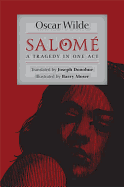
| Publisher: | University of Virginia Press | |
| Genre: | Performing Arts, Literary Collections, English, Irish, Scottish, Welsh, General, Screenplays, Playwriting, Theater, Drama | |
| ISBN: | 9780813931913 | |
| Pub Date: | October 2011 | |
| Price: | $24.95 |
| Performing Arts |
by Oscar Wilde, trans. by Joseph Donohue, illust. by Barry Moser
During an 1891 sojourn in Paris, Oscar Wilde was inspired by discussions with Stéphane Mallarmé and other Symbolist poets to take a biblical tale, set it as drama and write it in French, not English. Wilde was drawn to tales of decadence and beauty, and he couldn't do better than Salomé, teenage princess of Judea who became obsessed with John the Baptist, prisoner of her stepfather, Herod, and demanded John's head on a platter in exchange for performing the Dance of the Seven Veils. Wilde had a ball piling on out-of-control lust, family dysfunction, artsy striptease, beheading and necrophilia for maximum theatrical effect. He did so in highly stylized language that Joseph Donohue argues makes the drama in French one of "the greatest prose poems of them all."
While the play met with success at its French premiere, Wilde was less well served by the Lord Alfred Douglas English translation that has dominated discussion of English versions, to the detriment of the worth of the piece. Donohue provides a fascinating essay on Wilde's serious errors of judgment on that score; readers will take away lessons from Wilde's mistakes, including not hiring your boyfriend for a job for which he has no experience and not commissioning Aubrey Beardsley to illustrate a tale that happens somewhere other than an opium den.
Donohue renders Wilde's French tragedy in "an up-to-date, colloquial yet spare English translation" that could be performed on stage today. It reads smoothly, and he's breathed life back into the play. The ominous Barry Moser engravings also establish the time and place, mercifully free of a single Beardsley peacock feather. --John McFarland, author
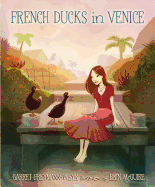
| Publisher: | Candlewick Press | |
| Genre: | Friendship, Animals, Love & Romance, Social Issues, Juvenile Fiction, Ducks, Geese, Etc. | |
| ISBN: | 9780763641733 | |
| Pub Date: | December 2011 | |
| Price: | $16.99 |
| Children's & Young Adult |
by Garret Freymann-Weyr, illust. by Erin McGuire
In this story of loss and healing through friendship and creativity, two French ducks stand in for children who may be processing similar changes in their own families.
Garret Freymann-Weyr, whose young adult novels (My Heartbeat; After the Moment) focus on a central event that results in the hero's maturity, here successfully translates her approach for a picture-book audience. For two French ducks living in Venice, California's canals, Polina Panova can do no wrong. She is, as Georges and Cécile (the French duck siblings) call her, "a Russian princess." She makes beautiful dresses in her canal-side bungalow, and adds to her fabrics a touch of "grass, flowers, pieces of the night sky, and strawberry jam." While Polina thinks her "prince" of a boyfriend, filmmaker Sebastian Sterling, makes her a princess, Georges and Cécile believe it's her dresses that grant her royal status. One day, Sebastian Sterling goes away, and suddenly Polina Panova is "a Russian princess without a prince." Georges becomes determined to find a present that will make Polina happy again.
First-time artist Erin McGuire's artwork accentuates the ducks' idealized image of Polina with scenes that resemble animation stills of princess fairy tales. She endows the French ducks with personality and perfectly captures the Pacific light that dances on the Venetian canals at dawn. This gentle story delivers a realistic yet hopeful message. Polina does, with Georges's gift, continue to do what she loves--making dresses. Although the hole left by the absence of a loved one can never truly be filled, one can, by doing what gives life meaning, find moments of happiness. --Jennifer M. Brown, children's editor, Shelf Awareness

| Publisher: | Holt | |
| Genre: | Juvenile Nonfiction, Boats, Ships & Underwater Craft, Military & Wars, Transportation, History, Canada - Post-Confederation (1867-) | |
| ISBN: | 9780805089455 | |
| Pub Date: | November 2011 | |
| Price: | $18.99 |
| Children's & Young Adult |
by Sally M. Walker
Sibert Award winner Sally M. Walker (Secrets of a Civil War Submarine; Written in Bone) brings to life the 1917 tragedy of two ships colliding in Halifax Harbour--the largest manmade explosion until Hiroshima--as she follows the members of five families through the event and its aftermath.
At 9:04 a.m. on December 6, 1917, 11-year-old Katharine Pattison was home sick with a cold; Gerald O'Brien, age seven, was skipping to the store to buy barley for his mother's soup; and 11-year-old Gerald Coleman, was preparing to serve as an altar boy at St. Joseph's Church. When the Mont-Blanc and the Imo collided in Halifax Harbour, their world literally exploded. The story begins with the physical layout of the harbor, its neighborhoods and the background of the two ships. Both were captained by capable men and served by competent crews. But one carried a hold full of explosives, and one false move resulted in catastrophe.
The well-designed volume clearly depicts the extent of the devastation in both words and photographs. The aftermath, involving daring rescues, identification of the dead, reconnecting family members separated by the blast, heroic relief efforts (which serve as a model for today's rescue missions) and months of reconstruction, will be as fascinating to readers as the disaster itself. The final chapter, "Time Passes," offers a moving and hopeful testimony to the ways the victims of tragedy choose to remember the past and how they move forward. As usual, this author's source notes and use of primary sources serves as a model of nonfiction writing. --Angela Carstensen, school librarian and blogger